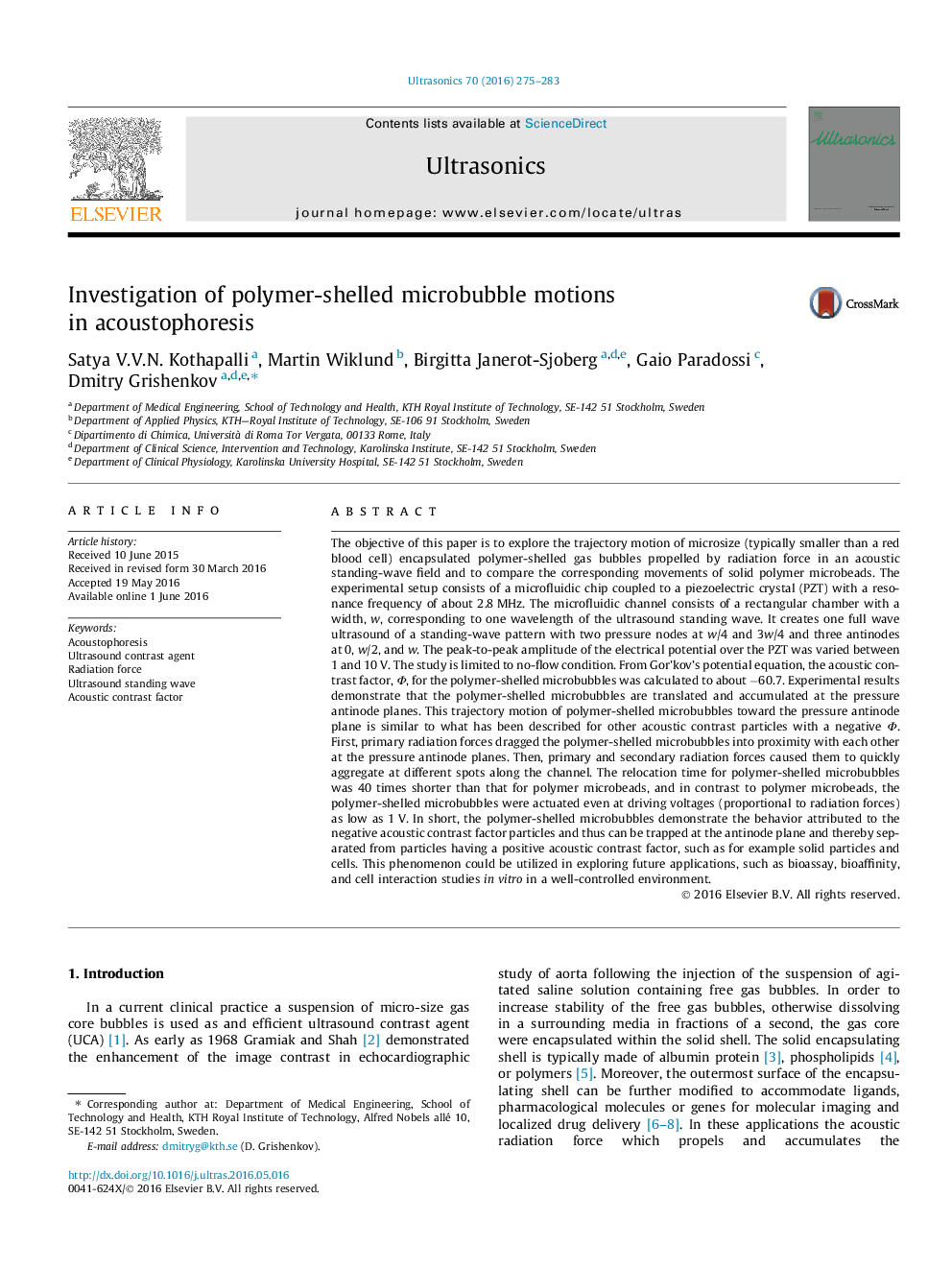| کد مقاله | کد نشریه | سال انتشار | مقاله انگلیسی | نسخه تمام متن |
|---|---|---|---|---|
| 8130265 | 1523199 | 2016 | 9 صفحه PDF | دانلود رایگان |
عنوان انگلیسی مقاله ISI
Investigation of polymer-shelled microbubble motions in acoustophoresis
دانلود مقاله + سفارش ترجمه
دانلود مقاله ISI انگلیسی
رایگان برای ایرانیان
کلمات کلیدی
موضوعات مرتبط
مهندسی و علوم پایه
فیزیک و نجوم
آکوستیک و فرا صوت
پیش نمایش صفحه اول مقاله

چکیده انگلیسی
The objective of this paper is to explore the trajectory motion of microsize (typically smaller than a red blood cell) encapsulated polymer-shelled gas bubbles propelled by radiation force in an acoustic standing-wave field and to compare the corresponding movements of solid polymer microbeads. The experimental setup consists of a microfluidic chip coupled to a piezoelectric crystal (PZT) with a resonance frequency of about 2.8 MHz. The microfluidic channel consists of a rectangular chamber with a width, w, corresponding to one wavelength of the ultrasound standing wave. It creates one full wave ultrasound of a standing-wave pattern with two pressure nodes at w/4 and 3w/4 and three antinodes at 0, w/2, and w. The peak-to-peak amplitude of the electrical potential over the PZT was varied between 1 and 10 V. The study is limited to no-flow condition. From Gor'kov's potential equation, the acoustic contrast factor, Φ, for the polymer-shelled microbubbles was calculated to about â60.7. Experimental results demonstrate that the polymer-shelled microbubbles are translated and accumulated at the pressure antinode planes. This trajectory motion of polymer-shelled microbubbles toward the pressure antinode plane is similar to what has been described for other acoustic contrast particles with a negative Φ. First, primary radiation forces dragged the polymer-shelled microbubbles into proximity with each other at the pressure antinode planes. Then, primary and secondary radiation forces caused them to quickly aggregate at different spots along the channel. The relocation time for polymer-shelled microbubbles was 40 times shorter than that for polymer microbeads, and in contrast to polymer microbeads, the polymer-shelled microbubbles were actuated even at driving voltages (proportional to radiation forces) as low as 1 V. In short, the polymer-shelled microbubbles demonstrate the behavior attributed to the negative acoustic contrast factor particles and thus can be trapped at the antinode plane and thereby separated from particles having a positive acoustic contrast factor, such as for example solid particles and cells. This phenomenon could be utilized in exploring future applications, such as bioassay, bioaffinity, and cell interaction studies in vitro in a well-controlled environment.
ناشر
Database: Elsevier - ScienceDirect (ساینس دایرکت)
Journal: Ultrasonics - Volume 70, August 2016, Pages 275-283
Journal: Ultrasonics - Volume 70, August 2016, Pages 275-283
نویسندگان
Satya V.V.N. Kothapalli, Martin Wiklund, Birgitta Janerot-Sjoberg, Gaio Paradossi, Dmitry Grishenkov,